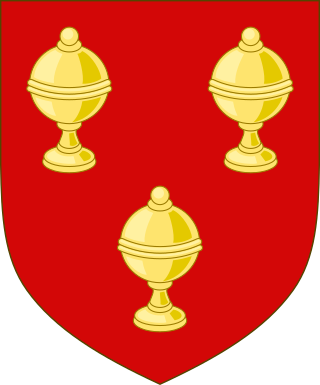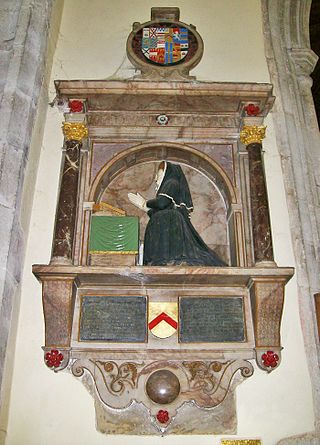
Thomas Boleyn, Earl of Wiltshire, 1st Earl of Ormond, 1st Viscount RochfordKGKB, of Hever Castle in Kent, was an English diplomat and politician who was the father of Anne Boleyn, the second wife of King Henry VIII, and was thus the maternal grandfather of Queen Elizabeth I. By Henry VIII he was made a knight of the Garter in 1523 and was elevated to the peerage as Viscount Rochford in 1525 and in 1529 was further ennobled as Earl of Wiltshire and Earl of Ormond.

The Palace of Beaulieu or Newhall is a former royal palace in Boreham, Essex, England, north-east of Chelmsford. The surviving part is a Grade I listed building. The property is currently occupied by New Hall School.

Earl of Mornington is a title in the Peerage of Ireland. It was created in 1760 for the Anglo-Irish politician and composer Garret Wellesley, 2nd Baron Mornington. On the death of the fifth earl in 1863, it passed to the Duke of Wellington; since that date, the title has generally been used by courtesy for the heir apparent to the heir apparent to the dukedom.

William Wellesley-Pole, 3rd Earl of Mornington,, known as Lord Maryborough between 1821 and 1842, was an Anglo-Irish politician and an elder brother of the Duke of Wellington. His surname changed twice: he was born with the name Wesley, which he changed to Wesley-Pole following an inheritance in 1781. In 1789 the spelling was updated to Wellesley-Pole, just as other members of the family had changed Wesley to Wellesley.
Viscount Rochford is a title that has been created twice in the Peerage of England.

The Other Boleyn Girl (2001) is a historical novel written by British author Philippa Gregory, loosely based on the life of 16th-century aristocrat Mary Boleyn of whom little is known. Inspired by Mary's life story, Gregory depicts the annulment of one of the most significant royal marriages in English history and conveys the urgency of the need for a male heir to the throne. Much of the history is highly distorted in her account.

Pishiobury, sometimes spelled Pishobury, was a manor and estate in medieval Sawbridgeworth, Hertfordshire. Its denomination as "Pishiobury" only emerged in the mid to late 19th century.

Wanstead House was a mansion built to replace the earlier Wanstead Hall. It was commissioned in 1715, completed in 1722 and demolished in 1825. Its gardens now form the municipal Wanstead Park in the London Borough of Redbridge.

William Richard Arthur Pole-Tylney-Long-Wellesley, 5th Earl of Mornington was a British nobleman.

William Pole-Tylney-Long-Wellesley, 4th Earl of Mornington was an Anglo-Irish nobleman notorious for his dissipated style of living.

Sir Robert Long, 6th Baronet, was an English politician.

Sir James Tylney-Long, 7th Baronet was an English politician who sat in the House of Commons for 32 years from 1762 to 1794.

Lady Margaret Boleyn was an Irish noblewoman, the daughter and co-heiress of Thomas Butler, 7th Earl of Ormond. She married Sir William Boleyn and through her eldest son Sir Thomas Boleyn, was the paternal grandmother of Anne Boleyn, second wife of King Henry VIII of England, and great-grandmother of Anne and Henry's daughter, Elizabeth I of England.
Sir William Stafford, of Chebsey, in Staffordshire was an Essex landowner and the second husband of Mary Boleyn, who was the sister of Anne Boleyn, Queen of England. Mary was one-time mistress of King Henry VIII of England.

Elizabeth Stafford, also known as Dame Elizabeth Drury and – in the years prior to her death in 1599 – Dame (Lady) Elizabeth Scott, was a Lady of the Bedchamber to Queen Elizabeth I. She and her first husband, Sir William Drury, entertained Queen Elizabeth I at Hawstead in 1578.
Elizabeth, Lady Boleyn was a lady-in-waiting at the court of Henry VIII of England. Through her marriage to Sir James Boleyn, she was the aunt of Henry VIII's second wife, Anne Boleyn. The two were not close, and Elizabeth Boleyn acted as her niece's gaoler when Queen Anne was arrested on charges of adultery, incest and conspiracy to kill the King.

Richard Child, 1st Earl Tylney, was an English politician who sat in the House of Commons between 1708 and 1734. Initially a Tory, he switched to supporting the Whigs after 1715. He held no Office of State, nor any commercial directorship of significance, but is remembered chiefly as the builder of the now long-demolished Palladian "princely mansion" Wanstead House, one of the first in the style constructed in Britain. In the furnishing of his mansion Child became the main patron of the Flemish painter Old Nollekens. He died in March 1750 aged 70 at Aix-en-Provence, France, and was buried on 29 May 1750 at Wanstead.

Earl Tylney, of Castlemaine in the County of Kerry, was a title in the Peerage of Ireland. It was created on 11 June 1731 for Richard Child, 1st Viscount Castlemaine. The Child family descended from the merchant, economist and colonial administrator Josiah Child, who on 16 July 1678 was created a baronet, of Wanstead in the County of Essex, in the Baronetage of England. The first Baronet was succeeded by his son from his second marriage, Sir Josiah Child, 2nd Baronet.

Longe is a surname of Anglo-Norman origin. The name Longe derives from the Anglo-Norman French ‘Lung’ or ‘Lang’ for tall or high. The family descend from the noble family of de Préaux who were barons in Préaux, Roumois and Darnétal, Normandy. Variants of the name include: le Long, de Long, Le Lung, Longe, Long and Longue. The family are believed to have arrived in England following the Norman Conquest and during the early 13th century divided into two branches, the Wiltshire branch and the Norfolk branch. In the Hundred Rolls of 1273, early variations have been found including, Henry le Longe in Buckinghamshire, John le Longe in Huntingdonshire; and Walter le Longe in Shropshire.
















